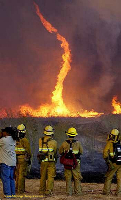© 2010 Naturesfury.net


What Is a Wildfire?
A wildfire also known as a wildland fire, forest fire, vegetation fire, grass fire, peat fire, bushfire (in Australia), or hill fire is an uncontrolled fire often occurring in wildland areas, but which can also consume houses or agricultural resources. Wildfires often begin unnoticed, but they spread quickly igniting brush, trees and homes.
Wildfires differ from other fires in that they take place outdoors in areas of grassland, woodlands, bush, scrubland, peat, and other woody materials that act as a source of fuel (or combustible material). Buildings are not usually involved, unless the fire spreads to adjacent communities and threatens these structures. Some of the defining characteristics of wildfires are the large area of burned land, upwards of 100,000 acres (404.7 km²) to 1,000,000 acres (4,046.9 km²), and higher; the velocity of the burning front, which can burn as fast as 6.8 mph (11 kilometres per hour) in forests and 14 mph (22 kilometres per hour) in grasslands; and the ability of the burning front to unexpectedly change direction and to jump across fire breaks. The intense heat and smoke can lead to disorientation and loss of appreciation of the direction of the fire.
Even before the flames of a wildfire arrive at a particular location, heat from the wildfire 'front' can precede the flames drying and pre-heating flammable materials, due to temperatures nearing 1,470 °F (800 °C). High-temperature and long-duration surface wildfires may encourage flashover or torching: the drying of tree canopy, the fuel, and their subsequent ignition from below.
What Causes a Wildfire?
Common causes of wildfires include lightning, human carelessness, arson, volcano eruption, and pyroclastic cloud from active volcano. Heat waves, droughts, and cyclical climate changes such as El Niño can also have a dramatic effect on the risk of wildfires. Although, more than four out of every five wildfires are caused by people.
Where Can Wildfires Occur?
Wildfires can occur anywhere, but are common in the forested areas of the United States and Canada. They are also susceptible in many places around the world, including much of the vegetated areas of Australia as well as in the Western Cape of South Africa. The climates are sufficiently moist to allow the growth of trees, but feature extended dry, hot periods. Fires are particularly prevalent in the summer and fall, and during droughts when fallen branches, leaves, and other material can dry out and become highly flammable. Wildfires are also common in grasslands and scrublands.

What Is a Fire Tornado?
A fire tornado or fire whirl is just a tornado made of fire. It happens when certain conditions (depending on air temperature and currents), acquires a vertical vorticity and forms a whirl, or a tornado-like effect. Fire tornadoes may be whirlwinds separated from the flames, either within the burn area or outside it. A fire tornado can make fires more dangerous.
Terms To Know
- SURFACE FIRES - The most common type of wildfires, surface fires move slowly and burn along the forest floor, killing and damaging vegetation.
- GROUND FIRES - These are usually started by lightning, ground fires burn on or below the forest floor through the root system.
- CROWN FIRES - These fires spread by wind moving quickly along the tops of trees.
- SANTA ANA WINDS - "Santa Ana" is the name given to the gusty northeast or east wind that occurs in Southern California during the fall and winter months. Santa Ana winds are often hot and very dry, greatly aggravating the fire danger in forests and bush lands.
- CONFLAGRATION - A large and destructive fire, typically aggravated by strong winds that carry firebrands over natural or artificial barriers.
